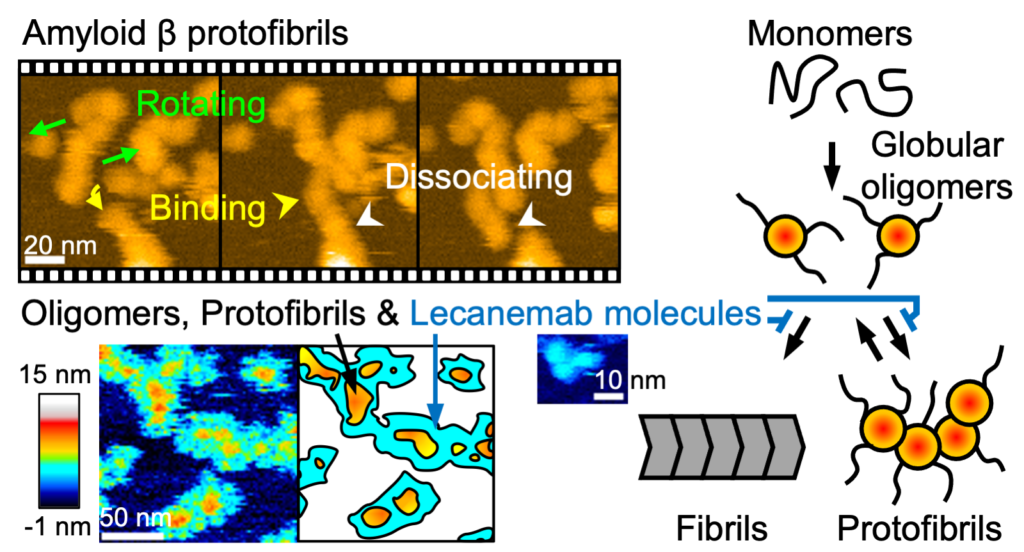Researchers at Kanazawa University report in Nano Letters how high-speed atomic force microscopy leads to insights into processes relevant to Alzheimer’s disease. Moreover, the technique is shown to be an excellent tool for studying the effect of drugs against the disease.
—————————————————————————————————————————————————————————————
High-speed atomic force microscopy and schematic visualization of protofibrils — dynamics, binding, dissociation and biochemical interactions.
According to the amyloid hypothesis, Alzheimer’s disease — the most common type of dementia — is caused by flaws in the production, accumulation, and disposal of amyloid-beta (Aβ) in the brain. Aβ refers to a group of peptides (protein fragments) that over time form plaques in the brain of people with Alzheimer’s disease. Drugs aiming to reduce the aggregation of Aβ have been developed, but recent findings show that different types of Aβ aggregates have different contributions to the development of Alzheimer’s disease. In particular, intermediate aggregates such as protofibrils are more toxic than the actual final fibrils, the main component of Aβ plaques. A precise understanding of the complex aggregation pathways is therefore necessary for the further development of efficient drugs against Alzheimer’s disease. Kenjiro Ono from Kanazawa University and colleagues have now succeeded in visualizing the structural dynamics of protofibrils, as well as the effect of a recently developed drug based on anti-Aβ antibodies.
The scientists looked at the formation and the structure of Aβ protofibrils by means of high-speed atomic force microscopy (HS-AFM). The latter method has in recent years emerged as a powerful nanoimaging tool for studying biomolecules and their dynamics at high spatiotemporal resolution. HS-AFM observations showed that protofibrils have a nodal structure, with stable structural features — specifically, the binding angle between nodes — across several samples. Importantly, this nodal structure is distinct from proper, mature fibrils, which have a helical structure.
Ono and colleagues then investigated the dissociation of protofibrils. They found that the length of protofibrils depends on their concentration, suggesting that aggregates can dissociate spontaneously.
To obtain detailed insights into the functioning of anti-Aβ antibody drugs, the researchers examined the binding between Aβ protofibrils and a new drug known as lecanemab. They found that the binding ability (affinity) of lecanemab for protofibrils is almost independent of the size of the protofibrils — in other words, the affinity does not substantially vary throughout the aggregation process. HS-AFM observations further revealed that lecanemab covers the surface of small, pre-protofibril aggregates. In doing so, the drug inhibits the further aggregation into protofibrils, which in turn prevents the formation of proper Aβ fibrils and plaques.
The results of Ono and colleagues provide direct evidence of a mechanism through which an antibody drug interferes with the Aβ aggregation process. More generally, the work confirms the versatility of the HS-AFM method for studying biochemical pathways. Quoting the scientists: “Single-molecule HS-AFM is an effective tool for revealing the structural dynamics of transient, metastable amyloid aggregation intermediates and the effects of anti-aggregating drugs on them.”
Background
High-speed atomic force microscopy
The general principle of atomic force microscopy (AFM) is to make a very small tip scan the surface of a sample. During this horizontal (xy) scan, the tip, which is attached to a small cantilever, follows the sample’s vertical (z) profile, inducing a force on the cantilever that can be measured. The magnitude of the force at the xy position can be related to the z value; the xyz data generated during a scan then result in a height map providing structural information about the investigated sample. In high-speed-AFM (HS-AFM), the working principle is slightly more involved: the cantilever is made to oscillate near its resonance frequency. When the tip is moved around a surface, the variations in the amplitude (or the frequency) of the cantilever’s oscillation — resulting from the tip’s interaction with the sample’s surface — are recorded, as these provide a measure for the local ‘z’ value.
HS-AFM results in a video, where the time interval between frames depends on the speed with which a single image can be generated (by xy-scanning the sample). Researchers at Kanazawa University have in recent years developed HS-AFM further, so that it can be applied to study biochemical molecules and biomolecular processes in real-time. Kenjiro Ono and colleagues have now applied the method to study the structural dynamics of amyloid-beta protofibrils, known to play a crucial role in the pathogenesis of Alzheimer’s disease, as well as the effect of an anti-amyloid-beta antibody drug against the disease.
Takahiro Watanabe-Nakayama, Mayumi Tsuji, Kenichi Umeda, Tatsunori Oguchi, Hiroki Konno, Moeko Noguchi-Shinohara, Yuji Kiuchi, Noriyuki Kodera, David B. Teplow, and Kenjiro Ono. Structural Dynamics of Amyloid‑β Protofibrils and Actions of Anti Amyloid‑β Antibodies as Observed by High-Speed Atomic Force Microscopy. Nano Lett. May 4, 2023.
DOI: 10.1021/acs.nanolett.3c00187
URL: https://pubs.acs.org/doi/abs/10.1021/acs.nanolett.3c00187




 PAGE TOP
PAGE TOP